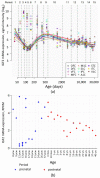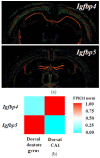Insulin-Like Growth Factor 2 As a Possible Neuroprotective Agent and Memory Enhancer-Its Comparative Expression, Processing and Signaling in Mammalian CNS
- PMID: 33673334
- PMCID: PMC7918606
- DOI: 10.3390/ijms22041849
Insulin-Like Growth Factor 2 As a Possible Neuroprotective Agent and Memory Enhancer-Its Comparative Expression, Processing and Signaling in Mammalian CNS
Abstract
A number of studies performed on rodents suggest that insulin-like growth factor 2 (IGF-2) or its analogs may possibly be used for treating some conditions like Alzheimer's disease, Huntington's disease, autistic spectrum disorders or aging-related cognitive impairment. Still, for translational research a comparative knowledge about the function of IGF-2 and related molecules in model organisms (rats and mice) and humans is necessary. There is a number of important differences in IGF-2 signaling between species. In the present review we emphasize species-specific patterns of IGF-2 expression in rodents, humans and some other mammals, using, among other sources, publicly available transcriptomic data. We provide a detailed description of Igf2 mRNA expression regulation and pre-pro-IGF-2 protein processing in different species. We also summarize the function of IGF-binding proteins. We describe three different receptors able to bind IGF-2 and discuss the role of IGF-2 signaling in learning and memory, as well as in neuroprotection. We hope that comprehensive understanding of similarities and differences in IGF-2 signaling between model organisms and humans will be useful for development of more effective medicines targeting IGF-2 receptors.
Keywords: CNS; IGF-binding proteins; IGF1R; IGF2R/CI-M6P; insulin receptor; insulin-like growth factor 2; learning and memory; neuroprotection; species-specific gene expression.
Conflict of interest statement
The authors declare no conflict of interest.
Figures







Similar articles
-
Expression of mRNA for the insulin-like growth factors and their receptors in human preimplantation embryos.Mol Reprod Dev. 1997 Jun;47(2):134-9. doi: 10.1002/(SICI)1098-2795(199706)47:2<134::AID-MRD2>3.0.CO;2-N. Mol Reprod Dev. 1997. PMID: 9136113
-
Quantitative analysis of insulin-like growth factor 2 receptor and insulin-like growth factor binding proteins to identify control mechanisms for insulin-like growth factor 1 receptor phosphorylation.BMC Syst Biol. 2016 Feb 9;10:15. doi: 10.1186/s12918-016-0263-6. BMC Syst Biol. 2016. PMID: 26861122 Free PMC article.
-
The Alzheimer's disease transcriptome mimics the neuroprotective signature of IGF-1 receptor-deficient neurons.Brain. 2017 Jul 1;140(7):2012-2027. doi: 10.1093/brain/awx132. Brain. 2017. PMID: 28595357
-
Insulin-like growth factor-2/mannose-6 phosphate receptors.Vitam Horm. 2009;80:667-97. doi: 10.1016/S0083-6729(08)00624-9. Vitam Horm. 2009. PMID: 19251055 Review.
-
The insulin-like growth factor-II/mannose-6-phosphate receptor: structure, distribution and function in the central nervous system.Brain Res Brain Res Rev. 2004 Mar;44(2-3):117-40. doi: 10.1016/j.brainresrev.2003.11.002. Brain Res Brain Res Rev. 2004. PMID: 15003389 Review.
Cited by
-
Plasma IGFBP-3 and IGFBP-5 levels are decreased during acute manic episodes in bipolar disorder patients.Front Pharmacol. 2024 Apr 24;15:1384198. doi: 10.3389/fphar.2024.1384198. eCollection 2024. Front Pharmacol. 2024. PMID: 38720780 Free PMC article.
-
Neural Stem Cell-based Regenerative Therapy: A New Approach to Diabetes Treatment.Endocr Metab Immune Disord Drug Targets. 2024;24(5):531-540. doi: 10.2174/1871530323666230512121416. Endocr Metab Immune Disord Drug Targets. 2024. PMID: 37183465 Review.
-
The IGF System and Aging.Endocr Rev. 2025 Mar 11;46(2):214-223. doi: 10.1210/endrev/bnae029. Endocr Rev. 2025. PMID: 39418083 Free PMC article. Review.
-
Changes in the Proteomic Profile After Audiogenic Kindling in the Inferior Colliculus of the GASH/Sal Model of Epilepsy.Int J Mol Sci. 2025 Mar 5;26(5):2331. doi: 10.3390/ijms26052331. Int J Mol Sci. 2025. PMID: 40076950 Free PMC article.
-
Neuroprotective effects of insulin-like growth factor-2 in 6-hydroxydopamine-induced cellular and mouse models of Parkinson's disease.Neural Regen Res. 2023 May;18(5):1099-1106. doi: 10.4103/1673-5374.355815. Neural Regen Res. 2023. PMID: 36254999 Free PMC article.
References
-
- Bracko O., Singer T., Aigner S., Knobloch M., Winner B., Ray J., Clemenson G.D., Jr., Suh H., Couillard-Despres S., Aigner L., et al. Gene expression profiling of neural stem cells and their neuronal progeny reveals IGF2 as a regulator of adult hippocampal neurogenesis. J. Neurosci. 2012;32:3376–3387. doi: 10.1523/JNEUROSCI.4248-11.2012. - DOI - PMC - PubMed
-
- Martín-Montañez E., Millon C., Boraldi F., Garcia-Guirado F., Pedraza C., Lara E., Santin L.J., Pavia J., Garcia-Fernandez M. IGF-II promotes neuroprotection and neuroplasticity recovery in a long-lasting model of oxidative damage induced by glucocorticoids. Redox Biol. 2017;13:69–81. doi: 10.1016/j.redox.2017.05.012. - DOI - PMC - PubMed
Publication types
MeSH terms
Substances
Grants and funding
LinkOut - more resources
Full Text Sources
Other Literature Sources
Medical
Research Materials
Miscellaneous

